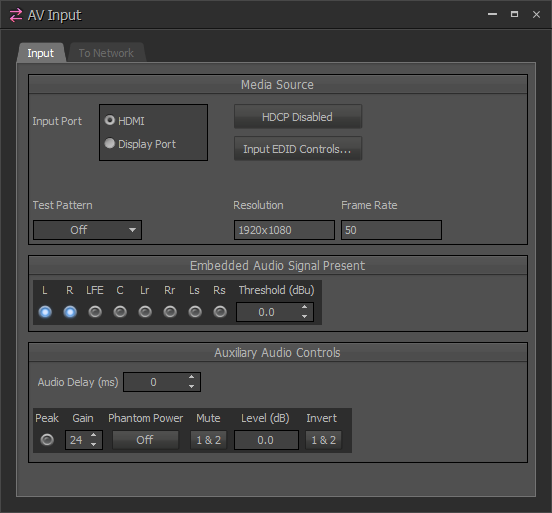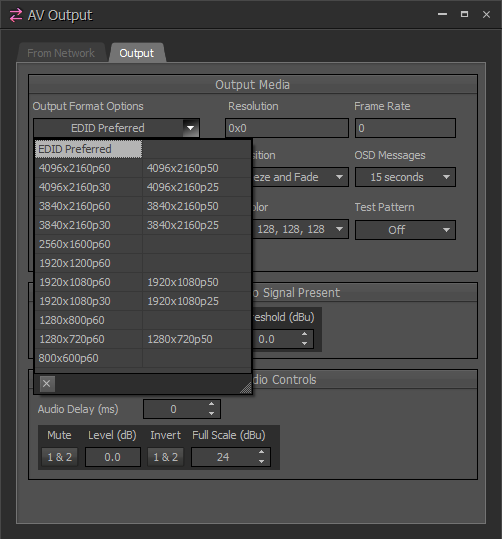TesiraLUX supported video formats
TesiraLUX will accept a variety of input formats, resolutions, scan rates and color spaces, and it intelligently handles delivering different formats across the network. This article details how different video formats are handled for network delivery.
Interlaced input
Standard video formats typically have Interlaced and Progressive transmission rates. Interlacing is a decades-old practice for television transmission and analog video connections, and it is becoming much less common. Interlaced video has been completely phased out for modern 4K UHD resolutions. Interlacing breaks the video frames into fields that alternate every other line. It is noted with an "i" after the resolution, such as 1080i or 720i. Interlacing can save considerable video bandwidth compared to progressive scanning. However, the process does impact quality, particularly for fast moving imagery, and it is not very conducive to compression for network transit. Modern digital transmission is eliminating the need for interlacing. TesiraLUX will accept interlaced video of common formats:
- 480i
- 576i
- 720i
- 1080i
The TesiraLUX IDH-1 input indicators will not differentiate between Progressive and Interlaced video formats. Input video will be deinterlaced by the TesiraLUX video engine before compression and network transit. TesiraLUX does not support interlaced video for HDMI outputs. All HDMI output is rendered as progressive formats.
Refresh rates
A key parameter of video is the image change rate. This is known is as the refresh rate or frame rate. Frame rate describes the recording or generation speed of the video. Refresh rate refers to the transmission update speed of video. The terms are related, often interchanged, but are not exactly the same. The standards of refresh rates for television transmission vary in different regions of the world. TesiraLUX accepts common input refresh rate modes up to 144hz:
- 24hz
- 25hz
- 30hz
- 50hz
- 60hz
- 144hz (eSports applications)
It is typical to find that computer generated images and monitors are operating at 60hz in nearly all areas of the world. The differences between 50hz and 60hz are more common in television broadcasts in different countries.
Drop Frame
TesiraLUX also support drop frame refresh rates. Drop frame is an artifact from a tradeoff necessary when color was first added to television transmission standards. Digital transmission standard do not require a frame drop as they now contain metadata.
Common frame drop refresh rates include:
- 24/1.001 or 23.98hz
- 30/1.001 or 29.97hz
- 60/1.001 or 59.94hz
TesiraLUX IDH-1 input indicators will not show drop frame rates. For example, an input of 59.94hz drop frame will show as 60hz in TesiraLUX.
Switching Between 50hz and 60hz Standards
TesiraLUX automatically manages switching between 50 or 25hz and 60 or 30hz standards depending on the detected input video signal. The AV Input block indicators will reflect 50hz or 25hz input when it is detected. This is also true for 24hz input.
In this example, 1080p50 is being delivered to the HDMI port of the TesiraLUX IDH-1.

The network stream will reflect the lower refresh rate. Note that the bandwidth controls will always show 60hz, 30hz, and 15hz options regardless of the input rate.
In this example, the 1080p50 input is being down converted to 25hz because the 30hz option is selected. TesiraLUX will automatically divide the input video refresh rate as necessary. Also note the bandwidth maximum is 0.73Gbps while only 0.58Gbps is being used. TesiraLUX will not up convert the frame rate from 50hz to 60hz because this would increase the network bandwidth for no resulting visual improvement.
Careful selection of the output video format should be considered when 50hz modes are on the network. Most modern monitors and projectors have a preferred mode of 60hz or 30hz in their EDID. TesiraLUX does not perform any pull down frame rate conversions. The resulting video between 50hz input and 60hz display will result in unsettling artifacts such as motion juddering.

TesiraLUX OH-1 has progressive 50hz and 25hz HDMI output modes. They can be manually selected on the AV Output block. The modes can also be included in presets or set by control automation and changed on the fly depending on the content type on the network.
Color formats
Color subsampling
TesiraLUX will accept input of 4:2:0, 4:2:2 and 4:4:4 color subsampling rates for all standard video formats. Standard PC timings and VESA formats are generally in the RGB color space and are accepted in TesiraLUX. RGB could be considered 4:4:4 from a bandwidth perspective but discrete red, green, and blue channels are not subsampled.
All color spaces are converted to YUV for network transit and subsampling. Output subsampling modes are supported depending on the preferred mode of the HDMI sink EDID.
Color space
Color space is an abstract mathematical definition for the range, or gamut, of color possible of a visual system and those are represented in numerical values. TesiraLUX will accept input of the following color spaces:
- sRGB
- sYCC
- xvYCC601
- xvYCC709
- sYCC601
- BT2020cYCC
- BT2020YCC
- BT2020RGB
TesiraLUX does not support user-defined or custom color space profiles. The color space of the TesiraLUX OH-1 HDMI output is not user-configurable and is dictated by the EDID of the HDMI sink device.
Bit depth
Bit depth is how many bits are used to describe each color channel in a pixel of a video signal, and it dictates the number of possible colors that can be reproduced. TesiraLUX supports input and output of bit-depths at 8-bits, 10-bits, 12-bits and 16-bits.
AVB streams are almost always transmitted over the network at 10-bits, with a 4:2:2 color subsampling. The only exception is transmitting uncompressed 4K@60Hz signals, which must be transmitted at 8-bit (4:2:0) because of bandwidth limitations. Reducing the frame rate of a 4K60 signal or applying any amount of compression to it will allow it to be transmitted at 10-bit color depth.
10-bit provides limited advantage if the HDMI or DP input is only 8-bits, which is true for the majority of current video content and video sources.
TesiraLUX cannot support 3D video.

